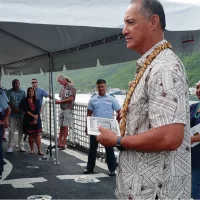
A story featured in the Honolulu Star Advertiser newspaper yesterday says American Samoa wants more help from the Coast Guard as Chinese fishing effort grows.
In 2007, there were about 100 Chinese-flagged vessels in the Pacific island region, and today there are now more than 540 that are active in the waters around American Samoa.
Director of Marine and Wildlife Resources Archie Taotasi Soliai told the newspaper, “This is directly related to the increase in China’s fishing effort.”
He said the Chinese presence is even larger than it appears on paper, with many Chinese companies registering vessels to Pacific island countries, a practice known as using “flags of convenience.”
“They can do almost anything […] they want to do without much accountability,” said Solial.
In 2020, the Coast Guard declared that illegal, unreported and unregulated fishing—or IUU—had surpassed piracy as the No. 1 global security threat at sea.
In October of that year, then-White House National Security Adviser Robert O’Brien announced that the Coast Guard would beef up its presence in the region and launch a $5 million study to look at stationing a ship in Pago Pago; and are adding new ones in Guam in an effort to combat overfishing, particularly by China’s fleet.
But ultimately, while the Coast Guard has increased its presence and stepped up operations in the region, the study concluded that American Samoa lacked the infrastructure to host a vessel.
American Samoan officials say that has left them exposed as the Chinese fleet continues making inroads in neighboring island countries.
Today, the US Coast Guard only maintains a small administrative office in Pago Pago and no vessels or aircraft.
Coast Guard vessels and planes stationed in Hawaii regularly visit American Samoa to conduct patrols, but Solial said Gov. Lemanu Palepoi Mauga and previous governors have been pushing for a permanent presence to protect the territory’s waters and provide on call search-and-rescue resources. “The response that we’ve gotten is we don’t have the resources or the infrastructure here,” said Solial.
Recently the Coast Guard assigned the CGC Harriet Lane, a 270-foot medium-endurance cutter with a crew of just under 100, to Honolulu as the “Indo-Pacific Support Cutter” dedicated to operations across Oceania. It’s currently on its first deployment in that new role and is expected to deploy across the region frequently, with fishery enforcement top priority.
American Samoa Government officials have pushed for stationing a Fast Response Cutter, a 154-foot vessel manned by a crew of just 24 people, in the territory. Since 2020, the Coast Guard has stationed three in Guam to support operations in Micronesia.
Soliai said “They’re fairly small, and that’s all we need,” and noted the lack of support is particularly frustrating given that, both, the Navy and Coast Guard were able to maintain bases and port vessels in Pago Pago in the past. “I think it’s hypocritical of (the federal government) to say that we need to increase our presence in the Pacific, and then you’ve got a U.S. territory that’s right in the middle of the most prolific fishing grounds in the world,” said Solial.
“It’s very hypocritical and a slap in the face that they may tell us that they want to increase efforts to combat IUU, and at the same time, not spend the resources we’re talking about.”




